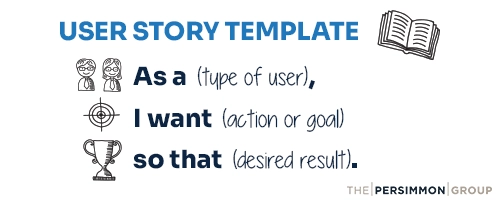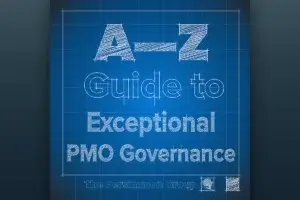Stuck on a Strategic Challenge? Try Writing a User Story.
When conventional approaches fall short, this structured technique borrowed from Agile methodology helps executive leaders reframe complex challenges through the lens of stakeholder value.
You’re facing a complex business challenge. Multiple stakeholders, competing priorities, and a maze of potential solutions. Sound familiar? Before diving into lengthy strategy sessions or expensive consultations, try this simple yet powerful technique borrowed from Agile software development: User Stories.
What are User Stories?
User stories are short, simple descriptions of a feature told from the perspective of the person who desires the new capability. Following a simple formula ensures clarity:
Format: As a [type of user], I want [some goal] so that [some reason].
While originally designed for software development, this framework can be a game-changer for tackling any business problem.
How User Stories Reveal the Way Forward
The true power emerges when you collect multiple stories across stakeholder groups. By mapping these varied perspectives, leaders can visualize the entire system of needs, constraints, and opportunities that define a complex challenge. Where traditional approaches might address single-point concerns, this ecosystem view reveals the intersections and boundaries where innovative solutions naturally emerge. The very process of articulating these diverse perspectives often makes the path forward surprisingly clear.
This simple structure accomplishes something powerful—it shifts focus from solutions to the underlying value that stakeholders seek. For executives, this represents a practical application of design thinking principles that grounds abstract challenges in concrete human needs.
Applying User Stories to Strategic Challenges: A Strategic Approach
Rather than jumping directly to potential solutions for organizational challenges, consider this structured approach:
- Identify all impacted stakeholder groups: Include both obvious stakeholders and those indirectly affected.
- Draft user stories for each stakeholder group: Aim for clarity about what each group needs and why it matters to them. Put one user story on one sticky note.
- Map the ecosystem of needs: Display the sticky notes, grouping by stakeholder group. The power of this approach comes from writing multiple user stories across stakeholder groups. This multi-perspective view reveals the complex forces and constraints shaping your challenge.
- Identify patterns and boundaries: Analyze your collection of stories to find common themes, conflicting needs, and constraints. These boundaries often become the catalyst for innovative solutions.
- Prioritize and design solutions: With a clear understanding of the ecosystem of needs, prioritize (negotiating any conflicting needs) based on strategic alignment
- Generate solutions: Use the stories as a guide to develop solutions that address multiple needs. Often, solutions will naturally reveal themselves—especially when harnessing the power of a group of problem-solvers.
From Software Development to Executive Decision-Making
What makes user stories so effective for organizational challenges?
- They create a shared language: Complex challenges often involve stakeholders from different departments who speak different “languages.” User stories create a common framework everyone can understand.
- They challenge assumptions: The process of writing stories often reveals that what executives think stakeholders want differs from their actual needs.
- They bridge strategy and execution: User stories create a clear line of sight between high-level strategy and concrete actions that deliver value.
- They reveal hidden value dimensions: By forcing articulation of the “so that” portion, user stories uncover what truly matters to each stakeholder group.
- They reveal invisible constraints: By capturing multiple perspectives, they reveal the boundaries within which solutions must work.
- They simplify prioritization: When faced with competing demands, the value-oriented nature of user stories makes trade-off decisions more transparent.
From Theory to Practice: A Real-World Example
Imagine your organization needs to redesign its performance management process—a complex challenge that impacts culture, operations, and strategic outcomes. Traditional approaches might focus immediately on benchmarking different rating systems or evaluation templates.
Instead, begin with user stories from key stakeholders:
- As a C-suite executive, I want to see how individual performance contributes to our strategic priorities so that I can ensure our workforce efforts align with business goals.
- As a department leader, I want to fairly evaluate both my marketing specialists and my data analysts so that each role type is judged by relevant criteria rather than a one-size-fits-all approach.
- As a manager, I want to have meaningful conversations about development throughout the year so that we can address performance gaps before the annual review time.
- As an individual contributor, I want to know exactly what’s expected of me and how I’ll be measured so that I can focus my energy on what truly matters.
- As an individual contributor, I want to be a voice in defining what excellence looks like in my role so that performance conversations are relevant to my daily work.
- As an HR director, I want insights into which skills exist and which are missing across departments so that we can plan targeted training and hiring initiatives.
With this ecosystem of stories mapped out, the constraints and opportunities become visible. Notice how the collection of stories reveals boundaries that no single perspective could provide. Within these boundaries, innovative solutions emerge. You might:
- Replace annual reviews entirely with a “performance portfolio” approach where achievements are documented and discussed in real-time throughout the year
- Implement “value contribution maps” that visually trace individual contributions to specific organizational objectives, helping everyone see their strategic impact
- Create stakeholder-designed success profiles where customers, peers, and partners help define what excellence looks like in each role
- Develop micro-learning challenges tied directly to identified skill gaps, turning development into an engaging, gamified experience
- Establish cross-functional “performance circles” where colleagues from different departments provide perspectives on contributions that might be invisible to direct managers
The result isn’t just a new performance management system—it’s a reinvention of how performance is understood, developed, and recognized across the organization.
User Stories as Design Thinking in Action
User stories represent design thinking principles applied to organizational challenges. They embody the core tenets of design thinking:
Human-centeredness: They focus on people’s actual needs rather than abstract processes
Problem reframing: They help redefine challenges from multiple perspectives
Iterative approach: They enable progressive refinement of solutions
Holistic perspective: They consider the entire ecosystem of stakeholders
For executives who appreciate design thinking but struggle to apply it practically, user stories offer a concrete, actionable starting point.
Moving From Insight to Action
To implement this approach in your organization:
Start small: Choose a moderately complex challenge as your test case
Involve diverse perspectives: Include representatives from various stakeholder groups
Keep stories visible: Display them prominently during planning and decision-making sessions
Revisit regularly: Use the stories to evaluate progress and realign efforts as needed
The Executive Advantage
While user stories may seem deceptively simple, their power lies in forcing clarity, alignment, and stakeholder focus—precisely what’s needed for complex organizational challenges.
The next time you face a complex organizational challenge, before commissioning another analysis or jumping to solutions, take a step back and ask: “As a [stakeholder], what do they really want, and why does it matter to them?” The answers might transform your approach entirely.












